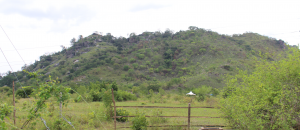Eviction from the Krobo Mountain
 The Krobo Mountain was the spiritual and physical home of the Krobo people. It was the first settlement of the Krobo people after the split from the other Dangme Groups in Lɔlɔvɔ.
The Krobo Mountain was the spiritual and physical home of the Krobo people. It was the first settlement of the Krobo people after the split from the other Dangme Groups in Lɔlɔvɔ.
The mountain was chosen because it was the ideal protection from the constant warfare at the time. In fact the Krobos won many wars by simply rolling bolders down the mountain – which would prevent the enemy from coming up and kill many of them in the process.
As the population increased, many Krobos would work on farms in the areas surrounding the mountain. The Mountain however continued to be the centre of culture, where all important rituals took place. Girls going through the Dipo would spend 1-2 years on the mountain going through the Dipo customs. It was Taboo for the Djemli (priests) to leave the mountain over night. Moreover as their ancestors were buried in family homes on the mountain, the mountain became the Ancestral home not just spiritually but literally.
However this proved a problem for the Colonial Government as the people were very hard to monitor and therefore control from their mountain settlements. Many reports came back that the seclusion of the mountain allowed certain warrior cults to be practiced and laws to be broken (e.g. only burying your dead in the cemetery) without repercussions. As a result the mountain was viewed by the colonial government as a Fetish mountain and when Governor Griffiths had the opportunity to remove the Krobo from the mountain – he did – with the Native Customs Ordinance of 1892. The Governor gave the people a total of three days to vacate the mountain. Many Krobo people were living in the surrounding areas at the foot of the mountain, working on their farms. And as you can expect for those at the foot of the mountain and further afield (some even a few days away), it is very hard to travel to the mountain, collect your belongings and bring them down within the three day limit. So people could only carry what they could and the rest was left on the mountain and later destroyed. The colonial government sent soldiers to destroy everything from the houses and Shrines to pots and even old trees.
It was a sad moment for the Krobo people, and that is why to this day both the Manya and Yilo Krobos organise a pilgrimage to the Mountain every year to commemorate this day. This pilgrimage usually occurs during the Ngmayem and Kloyosikplem festivals.
You can find out more The Native Customs ordinance used to evict the Krobo people here.
